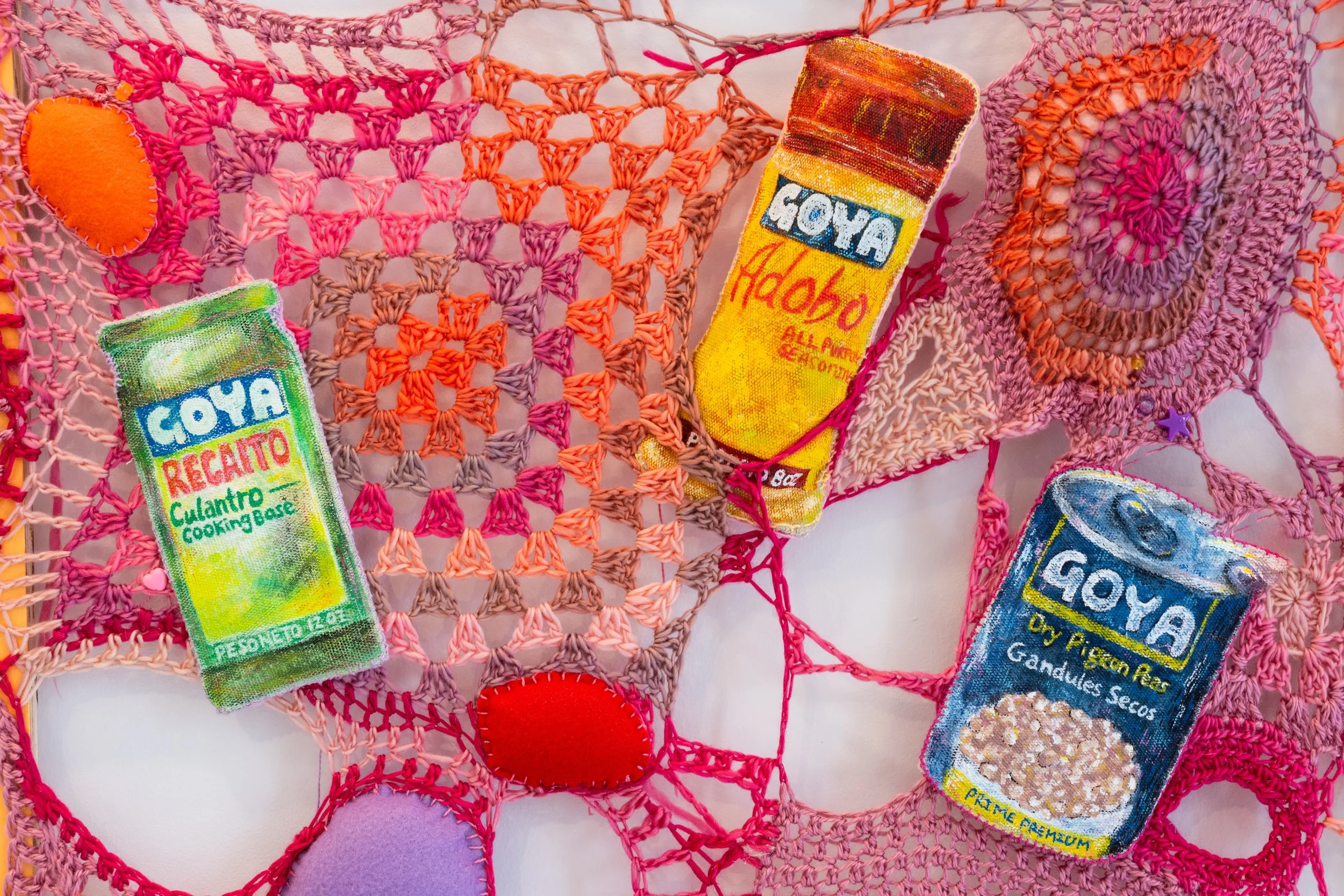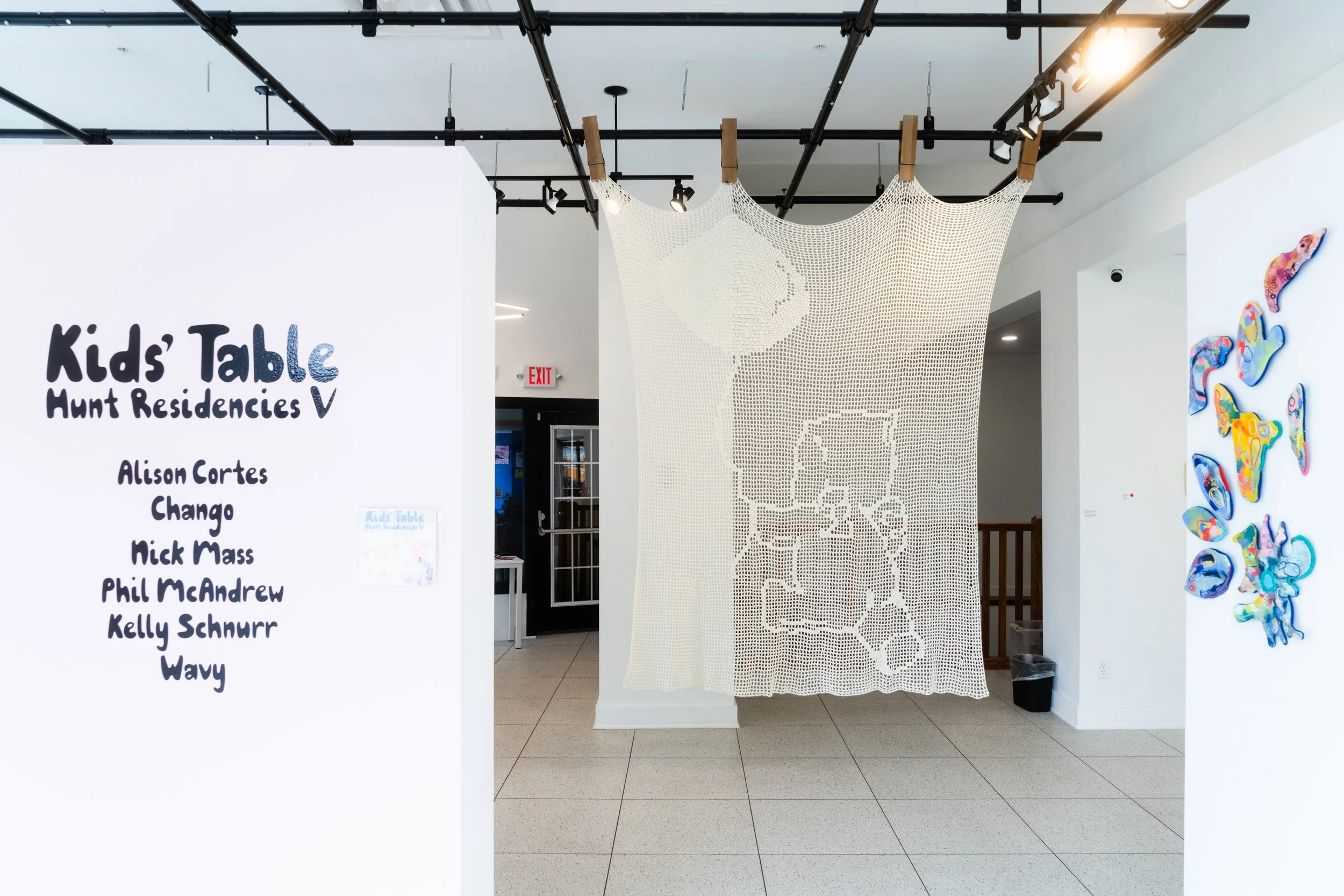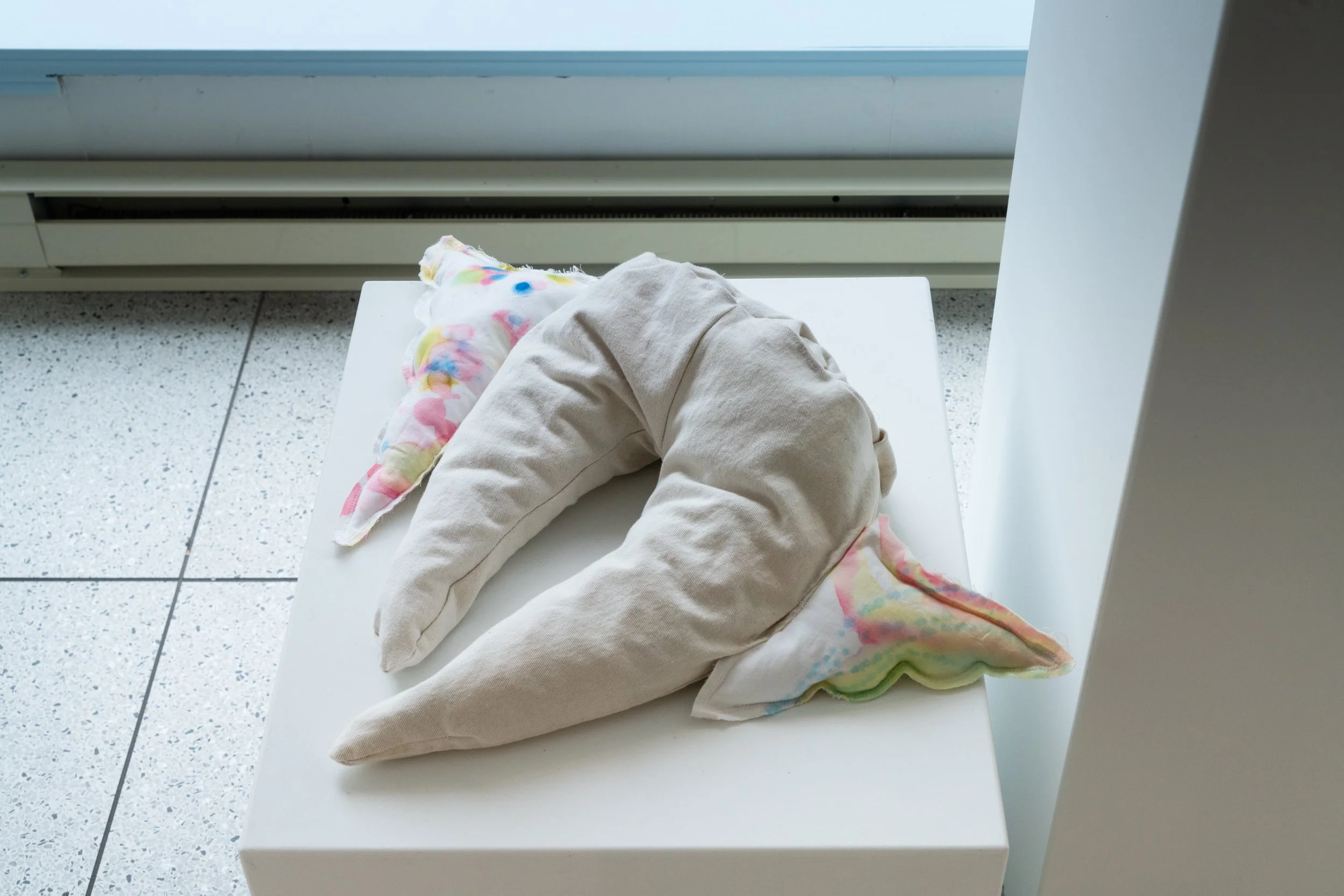Privatizing Childhood
Nostalgia, anti-capitalist survival, and the inner child in ‘Kids’ Table’
Alison Cortes, Kids’ Table, 2024, installation view, C. Stuart & Jane H. Hunt Art Gallery.
Photo: Nando Alvarez-Perez.
Last May, I wandered into Kids’ Table, the capstone exhibition of Hunt Art Gallery’s fifth residency cohort, featuring works by Chango, Alison Cortes, Nick Mass, Phil McAndrew, Kelly Schnurr, and wavy. Putting together a themed exhibition of six artists working independently in different mediums and with radically different styles can be an artificial process. Yet Kids’ Table proved to be a remarkably apt title. These six artists’ work, ranging from irreverent to optimistic, shared a preoccupation with turning toward the interiority, trauma, and involuntary memory of childhood in response to political, environmental, and economic precarity.
Among these works, Cortes’s and wavy’s mixed media and textile pieces struck me as uniquely compatible in their approach to childhood as a site of vulnerability and nostalgia. Nostalgia is a unique way to experience the past, characterized by involuntary memory and the particular aesthetics of softness—soft lighting, texture, color, aesthetic features—that convey affects like wistful positivity, comfort, and cuteness. Yet there’s another, less obvious link between Cortes’s and wavy’s work: even in a room full of works keenly aware of capitalism and politics, Cortes’s and wavy’s works are also the most direct in their references to commodities, whether by replicating brand iconography or by reusing the forms and materials of commercial goods.
If commodity capitalism is about the perpetual production and sale of objects and images through mechanical reproduction—a production technique that Marxist literary scholar Walter Benjamin linked to the proliferation of voluntary memory and claimed “reduces the scope for the play of the imagination”—how is it that the commodity form has provided such fertile ground for Cortes’s and wavy’s art?1 And do Cortes’s and wavy’s nostalgic commodities interrupt or reinforce the rhetoric of capitalist production?
* * *
At the heart of Kids’ Table—a title that references young adults’ perennial relegation to a separate table at our parents’ parties—is the figure of the child. At the heart of the figure of the child are questions of space and time. As queer theorist Lee Edelman observes, the child acts as a vessel for both biological and social reproduction: we reproduce human society by having children and by reinforcing social norms; children in turn replicate these norms in their own lives and those of their future children. The figure of the child thus serves as a discursive cudgel for making prescriptive claims about how the future should look. After all, it is nearly impossible to argue against someone who asks you to protect future generations, to “think of the children.” 2
Alison Cortes, Nana’s Pantry (detail), 2024. Crochet textile, canvas, embroidery thread, felt, beads, acrylic, oil pastel, 28 × 28 inches.
Courtesy of the artist. Photo: Nando Alvarez-Perez.
And yet we also live in a society where the kids are not alright, in large part because our parents’ generations leveraged the protection of children as a justification for protecting their own private interests: the continuous, ruinous extraction of natural resources; the production of commodities that exist to be wasted; the oppressive separation of public and private spaces; and the emphasis on policing the public to “protect” the private. The world we will inherit teeters on the brink of ecological and economic collapse—it is collapsing—because of choices made before we became adults. And our inheritance of that world continues to be delayed. If reaching adulthood is defined by access to private property and political power, most millennials and Gen Z—the generations wavy, Cortes, and I all straddle—have neither. Our homeownership and employment rates and our ability to amass capital and influence political regimes fall far behind those of our parents’ generations at our ages. Our third spaces keep getting taken away as well, defunded or overpoliced or both.
Where can we go if we can’t access the privatized workplace; if we lack the capital to access the private home or the pay-to-access social spaces of the café, the bar, or the restaurant; and if we have fewer unpoliced, free, public social spaces than ever? Back to our parents’ houses and to the kids’ tables; back to the experiential spacetime of childhood, the promises of adult futures floating just beyond our bedroom windows. And that’s only if we’re the lucky ones with parents who own or rent houses, with parents who can preserve these privatized childhood spaces as spaces of retreat.
On the surface, wavy’s and Cortes’s works address psychological interiority: Both their artist statements focus on the “inner child,” one who needs to be protected or preserved into adulthood. They express this interiority, however, through the paraphernalia that accumulates in private childhood spaces. Their works thus indicate how commodities and capitalist exchange dominate both the physical and psychological spaces of inner childhood.
wavy, Kids’ Table, 2024, installation view, C. Stuart & Jane H. Hunt Art Gallery.
Photo: Nando Alvarez-Perez.
Cortes’s work engages with girlhood and food as sites of nostalgia in ways that range from deceptively direct to knowingly ironic. Her work emphasizes brightly colored consumer goods, often food products labeled with specific brands. For example, her work Nana’s Pantry (2024) weaves realistically painted plushies of Goya bean and corn cans, foodstuffs the artist’s grandmother kept in her kitchen, into irregular pink crochet forms that evoke the organic cellular networks of a human stomach lining or intestines. It's as if to reference how commodities are both psychologically embedded in our lives and biologically embedded in our bodies.
Cortes’s oeuvre contains a few explicitly critical works, such as the somber brown and blue Corpor-Oats (2024) and Breath of Fresh Air (2024), featuring brand labels that proclaim their convenience “for workers on the go” or for those who want—and can afford to—“ditch the pollutants.” These dystopian products herald the positive feedback loop of companies’ profiteering from the ruinous living conditions they themselves create: the labor market that subsumes individual life, the unevenly distributed environmental disasters that make fresh air inaccessible. Such profiteering allows for the continuous generation of abstract “value” within the confines of the market even as the actual quality of our lives nosedives.
Yet even in Cortes’s more optimistic works—those with bright and unmuddied colors, soft and inviting textures, and/or cute slogans that teeter on the edge of platitudes—her visual language of nostalgia relies less on the food than on the commodity vessels in which it’s packaged and delivered—the juice box, the school lunch tray, the aluminum can. That nostalgia is thus laced with double meanings. The unmuddied colors of her juice boxes and lunch trays both communicate the optimism associated with childhood and demonstrate how a brand infuses its goods with that optimism: designing labels that catch children’s attention in a supermarket aisle, excite their imaginations, make them beg their parents to buy, and make them forever associate the brand with that sanctified joy. Cortes’s work thus communicates positive affects even as it questions them, highlighting how there is no optimism that cannot be bought or sold. We might even extrapolate that childhood optimism itself—as it has been rarefied and treated as a charmed and essential part of childhood along with childhood “innocence”—is a product created by adults. As Edelman points out, it is convenient for adults to position ”innocence” and childhood’s sense of possibility as unassailable when they want to use this rhetoric to get what they want.
wavy, transitional object: thinning veil, 2024. Distressed hospital baby blankets, upcycled cotton shirt, thread, styrofoam, newspaper, duct tape, plaster bandages. 40 × 11 × 12 inches.
Courtesy of the artist. Photo: Nando Alvarez-Perez.
Though wavy’s work also references brand iconography, most notably in the Kewpie doll on their monumental crochet piece the only finite element on the periodic table (2024), it draws attention to commodity culture primarily through the interactions and exchanges that invade the supposedly idyllic childhood sphere. Their work where does the tooth fairy keep all of our teeth? (2024) remixes one of the earliest monetary exchanges a child in the United States might experience: a baby tooth for a bit of our parents’ spare change, given under the guise of the “tooth fairy.” This work highlights the soft and insidious way childhood culture teaches us the rules of capitalist exchange—the production and sale of a bodily commodity (produced via biological “labor”) for capital—and makes that exchange fundamental to many rites of passage into adulthood.
The title of the work also cheekily points out the mystique built up around the tooth’s disappearance, a callout reminiscent of Marx’s articulation of the commodity fetish, that is, how commodities take on mystical value through exchange. That creation of mystical value by necessity distances commodities from their origins, both from the details of their production and from the idea that they had origins at all. Though Marx treats that distancing as a rhetorical trick, one that produces the idea of commodities as such, the material conditions of globalization—such as Western companies’ outsourcing of production to cheaper labor markets, particularly in southeast Asia—make that distancing literal. The goods we buy are physically distanced from their sites of production and disposal, an invisibly circular process of destructive extraction of resources and labor. Apart from the fine print that mentions country of origin on apparel labels, we see few reminders that these items are things that came from somewhere and will go somewhere when we’re done with them—and thus we’re given little prompting to consider the materials they’re made from or the people whose labor produced them.
wavy’s use of upcycled fabric also implicitly acknowledges how the outsourcing of labor and resource extraction manifests in the textile industry, long known for taking advantage of local economic necessity (itself produced and reinforced in part by predatory debts incurred from Western financial institutions) as well as inhumane labor practices. Though the viewer cannot identify the particular brand of upcycled jeans used in wavy’s tooth sculpture, the original use value of the transformed fabric (shredded or re-sewn as it is) remains apparent, inviting questions of the people involved in its creation. Similarly, no tags remain on the shredded baby blanket (wavy’s own, as it so happens) used in their transitional object: thinning veil (2024). However, this mass-produced blanket stands in for the “veil” through which we pass into life as infants, demonstrating how our lives are governed by medical bureaucracy and its commodities. Taken together, wavy’s work surfaces the labor of medical professionals and textile workers who now govern life in the most literal of ways.
Alison Cortes, Kids’ Table, 2024, installation view, C. Stuart & Jane H. Hunt Art Gallery.
Photo: Photo: Nando Alvarez-Perez.
Like Cortes’s optimistic commodities, wavy’s body of work does emphasize positive affects via pastel colors and soft cloth materials, placed in ways that reference the human body and invite comforting use. Lay your head down on this tooth-shaped pillow, or hide from the world behind this Kewpie curtain, these pieces seem to say. Certain nods to white, feminine bodies—the tapered skinny jeans suggested by the long roots of wavy’s baby tooth and the white-blond wig beneath the shredded veil—link this comfort to a brand of white femininity long associated with childlike innocence and the need for protection. This feminine cuteness brings to mind the cute-violence that cultural theorist Sianne Ngai identifies in many commodities designed to provide comfort to (primarily) white female audiences (for example, how stuffed toys or soft fabrics are meant to elicit the urge to manhandle and displace capitalism’s crushing pressure onto their softness). 3 That cute-violence is matched by the real violence white feminine “innocence” can wreak when used as a corollary to the child figure to signify what must be “protected”—a protection impulse used to justify the violent enforcement of racist and colonialist power structures. Linking the violence implicit to these cute and comforting aesthetics and affects to the literal violence that has defined these materials from the start of their commodity lives thus thins the veils, so to speak, between comfort and the violence necessary to produce it—the same violence against which that comfort is meant to safeguard.
These uneasy mixed messages built into Cortes’s and wavy’s textile and fiber works expose softness—the softness of nostalgia, the softness of the commodity—as a double-edged sword. The comfort and positive affects it evokes on a surface level can be deeply necessary for surviving a world in which social, economic, and environmental collapse under colonial systems of capitalist extraction feels crushing and imminent. Yet to treat the nostalgia and comfort of softness as an end in itself belies how child culture, particularly white girlhood culture, has been produced in part via commodity production itself, introducing and reproducing capitalist structures of exchange and capital accumulation via children who will become, or already are, laboring subjects and consumers. The turn toward privately owned nostalgic goods (stuffed animals, children’s cartoons, the retail therapy of clothes’ shopping and cutesy advertising) thus reproduces and reinforces the commodity culture that enacts so much violence across the world. Retreating into the realm of nostalgic commodities can thus become a deferral of social responsibility, a refusal to bear witness or act in solidarity, a distancing of the “home” sphere from the community, a privatization of positive affects.
The trouble with—or perhaps the power of—Cortes’s and wavy’s work is that, by necessity it offers both at once: genuine comfort and the critique of comfort’s commodification; positivity and the recognition of how, and for what purpose, positivity has been produced. On one hand, you might argue that critiquing capitalist optimism and comfort by embodying it only reinforces its rhetorical power. On the other hand, in a world where commodity forms have become so interwoven into our lives that even our childhood dreams take on their shapes, what other material do we have to work with? If, as Benjamin frequently argued, the space of imagination is forever shrinking under capitalism yet remains critical to resisting it, what choice do we have but to imagine otherwise using the flotsam of our lives?
* * *
wavy, where does the tooth fairy keep all of our teeth?, 2024. Upcycled denim, fiber scraps, thread. 20 × 29 × 6 inches.
Courtesy of the artist. Photo: Nando Alvarez-Perez.
As I write this, I am one year out of college. Some of my peers have jobs and have moved away from home; others have jobs but continue to live at home; others don’t have jobs at all. I don’t know anyone my age who’s on track to own a home without access to generational wealth. The further we’ve all wandered into so-called adulthood, the more I’m struck by how the gears of capitalist time are grinding themselves to a halt, producing the ruinous economic conditions that have set the traditional markers of adulthood—economic productivity, property ownership—out of reach. Maybe it makes sense that this material stoppage we’re experiencing has come coupled with the rise of nostalgic affects: as historian Svetlana Boym details, the experience of nostalgia, particularly its involuntary aspects, forces nonlinear temporal experiences. In fact, nostalgia only emerged as a recognized affect after the institutionalization of linear, productive, capitalist time; previously, nonlinearity was not revolutionary, not always against the grain, not always worth naming. 4
In a world where the pathway from childhood to adulthood has been linearized as a site of social reproduction, what can it mean that nostalgia lands us back in childhood and gums up the works of time? What does it mean that wavy’s use of upcycled materials upends the linear lifetime of a commodity from production to waste? What does it mean that both Cortes and wavy use crochet, one of few techniques that cannot be replicated by machine, requiring instead the slow, careful hand of the artist moving across a vast expanse of time? What does it mean to expose the seams and ragged edges of cardboard and tattered fabric in commodity objects, refusing machine-precision or smoothness? What does it mean when your nostalgia exists as a universe in a bowl of cardboard soup, or a curtain that fills half a room, impeding linear motion?
Childhood, like nostalgia, is not inherently revolutionary. It is not a resistance most of us chose. But to linger in childhood, cobbled together as it is from hopes and dreams and the detritus of all the meanings attached to it, is also a way of stopping time.
Kindness juice (grape flavored), childlike wonder (canned concentrate), second chances seltzer (98% effective): as Cortes’s shelf of cardboard products demonstrates, these are all promises bottled, canned, and sold back to us, even as our lives have become living proof of capitalism’s inability to deliver on these promises. Barred entry to our adulthoods, we see more clearly than ever the inundation of messages about where we’re supposed to want to go, who we’re supposed to become. We are still buying, of course—still drinking the kindness juice, still laying our heads down on the tooth pillow and dreaming about better lives. But for a moment we stand outside ourselves, outside the time of the transaction. Is it revolutionary? Is it all we’ve got?
Walter Benjamin, “On Some Motifs in Baudelaire,” in Illuminations (Mariner Books, 2019), 139.
Lee Edelman, “The Future Is Kid Stuff,” in No Future: Queer Theory and the Death Drive (Durham: Duke University Press, 2004), 1–31.
Sianne Ngai, “The Cuteness of the Avant Garde,” Critical Inquiry 31, no. 4 (Summer 2005): 811–47.
Svetlana Boym, The Future of Nostalgia (New York: Basic Books, 2001), 10.
by Kit Xiong
Kit Xiong is a Buffalo-based speculative fiction and nonfiction writer with a special interest in futurity and the intersections of science, tech, art, and literature. Find them on Substack @fishinthedesert.








